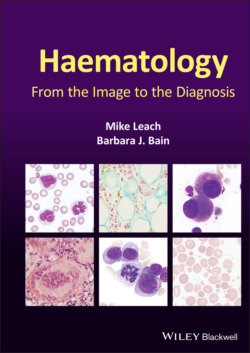Читать книгу Haematology - Barbara J. Bain, Irene Roberts - Страница 19
Оглавление10 T‐cell large granular lymphocytic leukaemia
A 53‐year‐old man with rheumatoid arthritis was referred on account of progressive neutropenia whilst on weekly methotrexate therapy. Importantly, the methotrexate was withheld but the neutropenia continued and in fact worsened. At the time of referral the full blood count showed Hb 159 g/l, WBC 6.5 × 109/l, neutrophils 0.6 × 109/l, lymphocytes 5.1 × 109/l and platelets 133 × 109/l. The lymphocytosis had actually evolved during the period when methotrexate was suspended. The blood film showed prominent large granular lymphocytes (top images ×100 objective) and on immunophenotyping these expressed CD8, weak CD5, CD2, CD3 and CD57, whilst expression of CD7 and CD26 was lost, suggesting a clonal T‐cell disorder. The bone marrow trephine biopsy sections showed a cellular marrow with a subtle interstitial (bottom left, H&E ×50) and intrasinusoidal (CD3, bottom centre and right, immunoperoxidase ×50) T‐cell infiltrate. T‐cell receptor gene rearrangement studies showed a clonal population, and sequencing of STAT3 and STAT5B genes showed a gain of function mutation in STAT3, Y640F, which has been associated with a therapeutic response to methotrexate. The clinical advice was therefore to restart methotrexate treatment. This resulted in improvement in rheumatic symptoms but also in resolution of lymphocytosis and neutropenia: Hb 160 g/l, WBC 5.0 × 109/l, neutrophils 2.1 × 109/l, lymphocytes 2.9 × 109/l and platelets 162 × 109/l.
Large granular lymphocytic leukaemia is a condition which should always be at the forefront of the mind of haematologists when investigating patients with cytopenias, particularly in the context of a known connective tissue disorder. Although a lymphocytosis is often apparent, the condition should also be considered when the count sits within the normal range. It is then important to scrutinise the blood film for granular lymphocytes and consider using flow cytometry to identify a possible aberrant T‐cell population.
MCQ
1 T‐cell large granular lymphocytic leukaemia:Can lead to anaemia due to pure red cell aplasia or autoimmune haemolytic anaemiaHas specific diagnostic features on trephine biopsyShows an association with Felty syndromeShows an association with thymomaTypically shows expression of CD3, CD8 and CD57For answers and discussion, see page 206.
